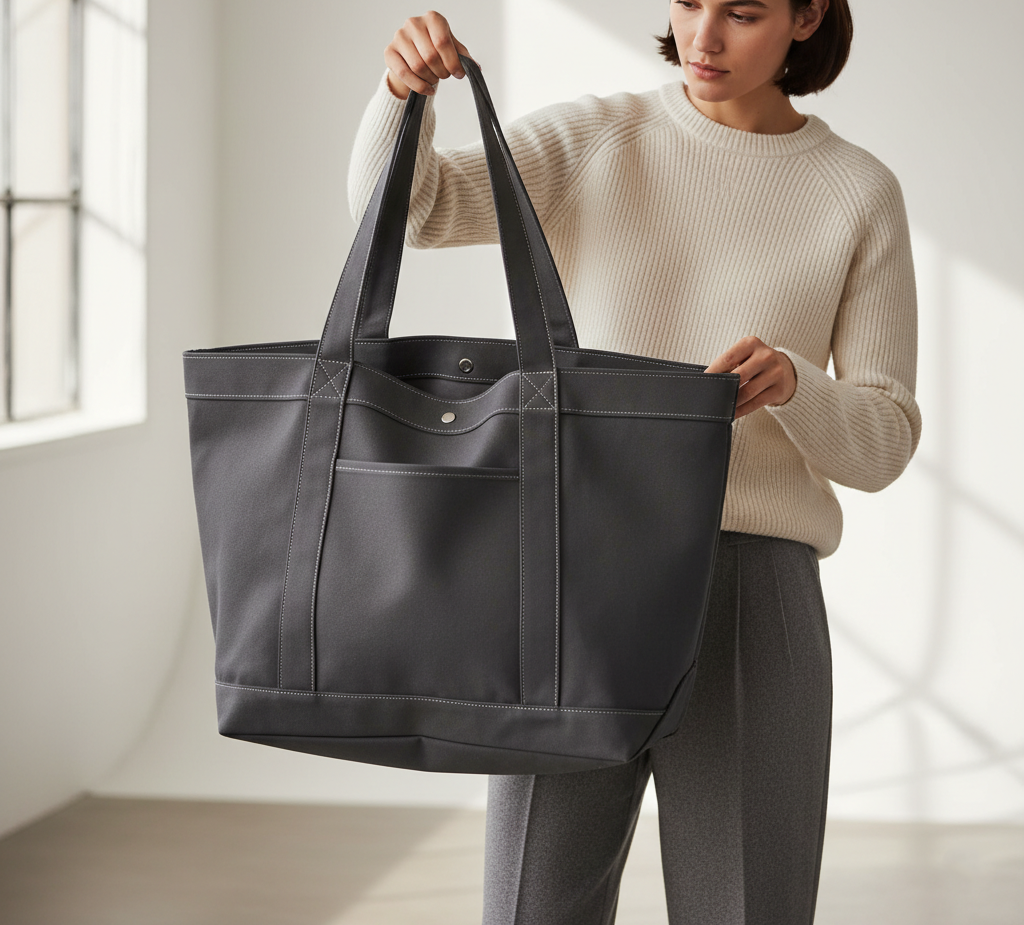How Recycled Totes Fit into a Minimalist Lifestyle

I've own and regularly used the same recycled tote bag for three years. It holds my laptop for work meetings, groceries on Saturday mornings, and everything I need for weekend trips. One bag. Multiple purposes. Zero regret about the purchase.
This is what minimalist living looks like in practice. Not deprivation. Not rigid rules about item counts. Just thoughtful choices that eliminate clutter while serving real needs. Recycled tote bags embody this philosophy perfectly. They combine design simplicity with environmental awareness, offering style that lasts longer and feels more intentional.
Here's how sustainable totes align with minimalist values and why one quality bag beats owning five mediocre ones.
What You'll Learn
- Why fewer bags with greater purpose defines minimalist thinking
- How recycled materials meet minimalist standards for quality and longevity
- The shared values between minimalism and sustainability
- How one versatile tote replaces multiple single-purpose bags
- Styling principles for pairing recycled totes with minimal wardrobes
Fewer Items, Greater Purpose
I used to own seven bags. A work tote. A gym bag. A beach bag. A travel duffel. A casual weekend bag. A shopping tote. A backup option for when the others were full or dirty.
Maintaining seven bags meant managing seven storage spots, remembering which bag held what forgotten item, and feeling vaguely stressed about whether I'd grabbed the right one for each outing. This is the opposite of what minimalism promises.
Minimalism asks a simple question: does this object serve multiple needs well, or does it serve one need barely? The answer determines what stays and what goes.
I replaced those seven bags with two. A minimalist tote for daily carry and a larger recycled weekender tote for travel. That's it. The mental space this freed up surprised me more than the physical closet space.
The right recycled tote eliminates decision fatigue. When you own one excellent bag instead of several adequate ones, you grab it automatically. No deliberation. No second-guessing. Just functionality that disappears into your routine, which is exactly what well-designed minimalism should do.
Shared Values Between Minimalism and Sustainability
I came to minimalism through a side door. I wasn't trying to embrace a lifestyle movement. I was tired of clutter and frustrated by how much time I spent managing possessions instead of using them.
Sustainability entered my thinking later. As I bought less frequently, I started noticing what I bought. Quality became more important than quantity. Durability mattered more than price. And the materials objects were made from started influencing my choices.
This is where minimalism and sustainability intersect naturally. Both movements prioritize thoughtful consumption over impulsive accumulation. Both value longevity over novelty. Both ask you to consider not just what you're buying, but why you're buying it and what happens to it after you're done with it.
Recycled totes sit perfectly at this intersection. They reduce demand for new resources, which aligns with sustainability goals. They're designed for years of use, which aligns with minimalist values about buying less often and buying better. And they offer the clean aesthetics that minimalist design favors.
I think of this as quiet sustainability. Not performative. Not loudly virtuous. Just consistent choices that add up over time. My recycled cotton tote doesn't announce its environmental credentials. It just performs reliably while happening to be made from reclaimed materials.
The focus shifts from trend-driven accumulation to pieces built for longevity. This shift feels like relief. There's freedom in opting out of constant newness in favor of things that simply work.
How Recycled Materials Meet Minimalist Standards
I'll be honest: I wouldn't carry a recycled tote if it was literally even slightly worse than conventional bags. Minimalism values function over sentiment. Environmental awareness matters, but not at the expense of daily practicality.
The materials prove themselves. Recycled cotton maintains the softness and breathability of virgin cotton while diverting textile waste from landfills. Reclaimed nylon offers the same water resistance, durability, and light weight as new nylon, just sourced from ocean plastics or discarded fishing nets instead of petroleum.
Recycled canvas surprises people with its quality. The fabric is substantial. The weave is tight. The material doesn't feel like a compromise - it feels like an upgrade from flimsy synthetic alternatives.
These materials often require less water and energy to produce than their virgin counterparts. This matters from a sustainability perspective. From a minimalist perspective, what matters is that the materials deliver performance equal to or better than traditional options.
My three-year-old recycled nylon tote shows minimal wear. The fabric hasn't faded. The stitching remains intact. The water-repellent coating still beads moisture. I've put this bag through airport security dozens of times, stuffed it full of groceries, used it as a gym bag when needed, and carried it daily for work. It looks like a bag that's been used, not a bag that's worn out.
This is the durability minimalism demands. Objects should earn their place through consistent performance over time. Recycled materials achieve this while carrying the additional benefit of reduced environmental impact.
Design Restraint Enables Versatility
The minimalist aesthetic gets stereotyped as boring. All beige. All neutral. All safe. I understand the critique, but I think it misses the point.
Restraint in design isn't about avoiding interest. It's about creating flexibility. A minimalist tote in black, grey, navy, or tan pairs with everything I own. This isn't boring, this is strategic. One bag works with tailored trousers and a blazer for client meetings, with jeans and a sweater for weekend errands, and with athletic wear for gym sessions.
Clean lines and functional interiors make recycled totes adaptable across contexts. My primary tote includes interior pockets for organization, a padded laptop sleeve, and reinforced straps for carrying weight comfortably. These features serve practical needs without decorative excess.
The design restraint becomes the reason for versatility. A bag covered in logos, patterns, or trend-specific details limits when and where you can carry it. A thoughtfully designed eco-friendly tote in a neutral palette goes anywhere.
I've carried my canvas tote to professional conferences, casual dinners, grocery stores, farmers markets, and weekend getaways. The same bag. Different contexts. Zero fashion friction.
This is what I mean by greater purpose. The bag doesn't just carry things. It simplifies my entire approach to daily organization by being appropriate for every situation I encounter regularly.
One Bag, Many Roles
The minimalist approach favors multi-purpose design. I test this principle with every object I own: can this serve multiple needs, or does it only address one narrow function?
My recycled tote passes this test easily. During the week, it's my work bag. Laptop, notebook, charger, water bottle, lunch, and miscellaneous necessities. The structured shape keeps everything organized and accessible.
On weekends, the same bag becomes a casual carryall. Farmers market haul. Library books. A change of clothes for dinner after an afternoon hike. The soft construction expands to accommodate irregular items without losing shape.
For short trips, the tote converts into a travel bag. It fits under airplane seats. It holds two days' worth of clothing plus toiletries. The lightweight materials don't add unnecessary weight when I'm already carrying it through airports or train stations.
This versatility eliminates the need for multiple specialized bags. I don't need a separate work tote, weekend bag, and travel duffel. One quality recycled weekender tote handles all three roles competently.
The value lies in how this simplifies routines. I don't stand in my closet deciding which bag to use. I don't transfer essentials from bag to bag depending on the day's plans. I grab the same tote, and it works.
This aligns perfectly with the minimalist goal of reduction through intention. Fewer items. Greater utility. Less mental overhead.
Styling with Simplicity
I dress in neutrals. Not exclusively, but predominantly. Black, white, grey, navy, camel, olive. This isn't a strict uniform, but more of a framework that eliminates decision fatigue while maintaining options.
My recycled cotton tote in charcoal grey complements this wardrobe effortlessly. It pairs with monochrome outfits without visual conflict. It balances earth tones without competing for attention. The material texture provides interest without pattern or embellishment.
This is the understated aesthetic minimalism favors. Accessories stay subdued, letting quality materials and thoughtful construction take focus. A well-made sustainable tote becomes a visual anchor. Something functional yet refined.
I appreciate bags that don't demand attention. My tote doesn't make statements about my personality or broadcast affiliations. It just performs its function while looking intentional. This quiet competence appeals to me more than any logo or trend-driven design ever would.
Pairing recycled totes with minimal wardrobes requires no special styling knowledge. Neutral bag plus neutral clothing equals cohesion. The simplicity is the point.
Why I Choose Recycled Materials
I choose recycled materials for practical and philosophical reasons. Practically, they perform as well as virgin materials while often costing less. Philosophically, they represent progress toward less wasteful production methods.
The fashion industry produces staggering amounts of waste. Textile scraps, unsold inventory, post-consumer clothing, all of these contribute to landfill overflow. Recycled materials divert some of this waste back into production cycles. This doesn't solve every environmental problem, but it represents improvement.
I prefer incremental progress over waiting for perfect solutions. Recycled totes aren't flawless. Production still requires energy and resources. Dyes still use chemicals. Shipping still produces emissions. But they're measurably better than conventional alternatives in most metrics.
This aligns with minimalist thinking about realistic improvement over idealistic perfection. I can't eliminate my environmental impact entirely. I need bags to carry things. So I choose bags made from recycled nylon, recycled canvas, or organic cotton when options exist.
The decision feels consistent with my overall approach to consumption: buy less frequently, choose better quality, prioritize durability and materials that minimize harm.
The LuxaTote Perspective
When I evaluate bags for our collection at LuxaTote, I apply the same criteria I use personally. Does the design serve multiple purposes? Will the materials last years of regular use? Does the construction justify the price?
We select recycled and sustainable totes that meet minimalist standards for quality and versatility. The materials like recycled cotton, vegan leather, and eco-friendly canvas, are chosen for strength and texture, not just environmental credentials.
Each sustainable tote in our collection represents a commitment to simplicity that lasts. The goal isn't to produce more bags. It's to curate better options for people who value thoughtful design and responsible materials.
This curation philosophy mirrors minimalist principles. Offering fewer, better choices feels more honest than overwhelming people with endless options. When every bag meets high standards for quality and durability, choosing becomes simpler.
Sustainability as Refinement
Minimalism is often described as an aesthetic. Clean lines. Neutral colors. Sparse interiors. These visual elements are real, but they're surface expressions of deeper principles.
At its core, minimalism is an ethic. It's about intentionality. About questioning default consumption patterns. About finding sufficiency rather than constantly seeking more.
A recycled tote expresses this principle without excess or compromise. Its value comes from use, not from novelty. Every carry becomes part of a longer story of durability and care.
This is the quiet satisfaction minimalism offers. Not dramatic transformation. Not rigid rules. Just consistent choices that compound into a simpler, more intentional way of moving through the world.
One quality recycled tote bag. Multiple purposes. Years of use. That's the entire philosophy in one object.
Explore our curated selection of sustainable and eco-friendly totes designed for minimalist lifestyles and built to last.

0 comments